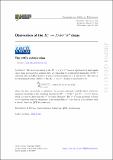Observation of the B+ c → J/ψπ+π 0 decay
Author(s)
Aaij, R.; Abdelmotteleb, A. S. W.; Abellan Beteta, C.; Abudinén, F.; Ackernley, T.; Adams, J. A.; Adefisoye, A. A.; Adeva, B.; Adinolfi, M.; Adlarson, P.; Agapopoulou, C.; Aidala, C. A.; Ajaltouni, Z.; Akar, S.; Akiba, K.; Albicocco, P.; ... Show more Show less
Download13130_2024_Article_23275.pdf (928.8Kb)
Publisher with Creative Commons License
Publisher with Creative Commons License
Creative Commons Attribution
Terms of use
Metadata
Show full item recordAbstract
The first observation of the
B
c
+
→
J
/
ψ
π
+
π
0
$$ {B}_c^{+}\to J/\psi {\pi}^{+}{\pi}^0 $$
decay is reported with high significance using proton-proton collision data, corresponding to an integrated luminosity of 9 fb−1, collected with the LHCb detector at centre-of-mass energies of 7, 8, and 13 TeV. The ratio of its branching fraction relative to the
B
c
+
→
J
/
ψ
π
+
$$ {B}_c^{+}\to J/\psi {\pi}^{+} $$
channel is measured to be
B
B
c
+
→
J
/
ψ
π
+
π
0
B
B
c
+
→
J
/
ψ
π
+
=
2.80
±
0.15
±
0.11
±
0.16
,
$$ \frac{{\mathcal{B}}_{B_c^{+}\to J/\psi {\pi}^{+}{\pi}^0}}{{\mathcal{B}}_{B_c^{+}\to J/\psi {\pi}^{+}}}=2.80\pm 0.15\pm 0.11\pm 0.16, $$
where the first uncertainty is statistical, the second systematic and the third related to imprecise knowledge of the branching fractions for B+ → J/ψK*+ and
B
c
+
→
J
/
ψ
π
+
$$ {B}_c^{+}\to J/\psi {\pi}^{+} $$
decays, which are used to determine the π0 detection efficiency. The π+π0 mass spectrum is found to be consistent with the dominance of an intermediate ρ+ contribution in accordance with a model based on QCD factorisation.
Date issued
2024-04-30Department
Massachusetts Institute of Technology. Department of PhysicsPublisher
Springer Science and Business Media LLC
Citation
The LHCb collaboration., Aaij, R., Abdelmotteleb, A.S.W. et al. Observation of the 𝐵+𝑐→𝐽/𝜓𝜋+𝜋0 decay. J. High Energ. Phys. 2024, 151 (2024).
Version: Final published version
ISSN
1029-8479